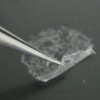.jpg)
Burn wounds are famously prone to infection, requiring careful management and bandaging that stays constantly in contact with the skin. It’s manageable enough to keep bandages in place on large areas like the torso, but when treating fingers, ears, and toes the modern bandage is simply not flexible enough. Researchers at Tokai University in Japan have now developed a new material that is very thin and extremely flexible, and that has already been tested as a bandage on laboratory animals.
The material is made out of nanosheets of a biodegradable polyester called poly(L-lactic acid), or PLLA. These are basically spun in a blender with water to break them up into tiny pieces, resulting in a nanosheet shake. This liquid is then poured onto a flat surface and allowed to dry. The final ultra flexible product is a nanosheet itself, but composed of patches of nanosheet fragments. At the ongoing National Meeting & Exposition of the American Chemical Society, the team reported on testing the material on the toes of mice. They showed that the substance coats even the tiniest flaps and bumps on the skin, and once dryed, it clung to the skin securely in place. Moreover, testing on real wounds, they demonstrated that the new material kept out the Pseudomonas aeruginosa bacteria tha often causes infections.
From the American Chemical Society:
The dressing protected wounds from infection for three continuous days. With an additional coating, the nanosheets kept bacteria out for a total of six days. That means the material, if eventually approved for human patients, could cut down the number of times dressings have to be changed. With an eye toward human clinical trials, the researchers are currently planning large-scale animal tests and safety tests.
In addition to PLLA nanosheets, Okamura’s group has recently started developing a novel set of similar, super-flexible, patchwork coatings composed of polymers with a phosphorylcholine group. They have shown that these materials are compatible with blood and could act as coatings for medical devices, such as catheters.
source:Bioserenity
New Bandage Material Wraps Around Every Wrinkle

